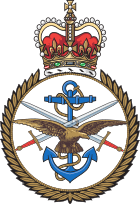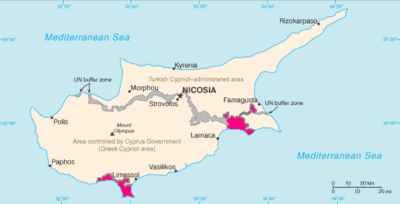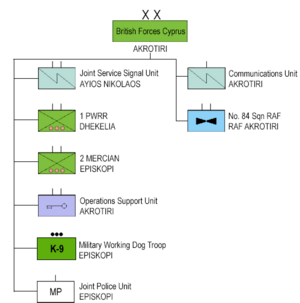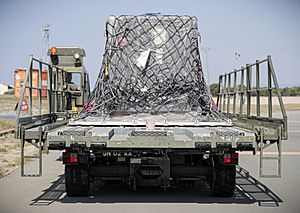British Forces Cyprus facts for kids
Quick facts for kids British Forces Cyprus |
|
|---|---|

British Forces Tri-Service badge
|
|
| Allegiance | |
| Branch | |
| Size | 3,500 military personnel 7,000 civilians |
| Part of | UK Ministry of Defence |
| Garrison/HQ | Akrotiri and Dhekelia, Cyprus |
| Commanders | |
| CBF (Commander British Forces Cyprus) | Air Vice-Marshal Peter Squires OBE |
| Notable commanders |
Air Chief Marshal Sir Michael Wigston KCB CBE ADC |
British Forces Cyprus (BFC) is the name for the British military groups based on the island of Cyprus. They are located in special areas called Sovereign Base Areas, which belong to the UK. They also use other agreed-upon sites in the Republic of Cyprus. The UK keeps its forces there because Cyprus is a very important spot in the eastern Mediterranean Sea. It's a useful place for troops to stop before going to places in the Middle East and Asia. BFC includes all three main parts of the British military: the British Army, Royal Air Force, and Royal Navy.
Contents
History of British Forces in Cyprus
When Cyprus became independent in 1960, the UK kept two special areas, Akrotiri and Dhekelia. The UK also got to use 40 other military sites across Cyprus. These sites included radar stations, ports, and places for soldiers to live and train.
Soon after, a group called 'British Forces Near East' was formed. Its leader also managed the special UK areas in Cyprus. In 1961, a part of the Royal Air Force in the Middle East moved to Cyprus. It was renamed the 'Near East Air Force'. By 1962, the name 'British Forces in Cyprus' was officially used.
In 1976, it was noted that Cyprus was very important for the UK's military. It helped with air travel for forces moving to areas east of the Suez Canal. Radar sites and fighter planes in Cyprus were also seen as part of a wider air defense system.
Today, British Forces Cyprus still uses 13 of the original 40 sites. The other 27 sites were given back to Cyprus when the UK military no longer needed them. For example, the Berengaria Married Quarters were returned in 2011. A firing range on the Akamas peninsula was returned between 1999 and 2001. This was because its training value was less important than protecting the environment.
How British Forces Cyprus is Organized
The main office for British Forces Cyprus is at Episkopi Cantonment. The Commander British Forces Cyprus (CBF) is a high-ranking officer. This role switches every three years between a major-general from the British Army and an air vice-marshal from the Royal Air Force. The Chief of Staff British Forces Cyprus (COS) is also a high-ranking officer from the other service.
Episkopi Cantonment is also home to the Sovereign Base Areas Administration. This is the civilian group that manages the UK territory.
Many British forces in Cyprus are rotated, meaning they come from the UK for a period. However, some units are based there permanently:
- Permanent Units
- Headquarters (HQ), British Forces Cyprus
- Joint Service Signal Unit (Cyprus) at Ayios Nikolaos Station. This unit handles military communications.
- Cyprus Communications Unit.
- Cyprus Operations Support Unit. This unit helps with transport, engineering, and air operations.
- No. 84 Squadron RAF. This is a Royal Air Force squadron.
- No. 15 Squadron RAF Regiment. This unit protects the forces.
- Resident infantry battalions. Two infantry battalions are always based on the island. One is at Dhekelia Cantonment and one at Episkopi Cantonment. These battalions usually change every two years.
- 1st Battalion The Princess of Wales's Royal Regiment
- 1st Battalion The Duke of Lancaster's Regiment
- Cyprus Military Working Dog Troop, Episkopi. This unit uses trained dogs for military tasks.
- Cyprus Joint Police Unit (CJPU), HQ Episkopi. This is a military police unit with members from the Royal Navy Police, Royal Military Police, and RAF Police.
- Civilian Components
- Sovereign Base Areas Customs
- Sovereign Base Areas Police
- Security Force Police
- Health Services
- Joint Services Health Unit. This unit provides health care.
Infantry battalions from the Queen's and King's Divisions continue to rotate through Cyprus every three years.
Commanders of British Forces Cyprus
Here are some of the officers who have led British Forces Cyprus:
General Officer Commanding Cyprus District
- 1955 — Major-General Abdy Ricketts
- 1956 — Major-General Douglas Kendrew
- 1958 — Major-General Kenneth Darling
Commander, British Forces in Cyprus
- 1960 — Air Marshal Sir William MacDonald
- 1962 — Air Chief Marshal Sir Denis Barnett
- 1964 — Air Marshal T O Prickett
- 1966 — Air Marshal E G Jones
- 1969 — Air Marshal D G Smallwood
- 1970 — Air Marshal W D Hodgkinson
- 1973 — Air Marshal Sir John Aiken
Commander, British Forces Cyprus
- 1976 — Air Vice-Marshal R D Austen-Smith
- 1978 — Major-General W R Taylor
- 1980 — Air Vice-Marshal R L Davis
- 1983 — Major-General Sir Desmond Langley
- 1985 — Air Vice-Marshal K W Hayr
- 1988 — Major-General J P W Friedberger
- 1990 — Air Vice-Marshal A F C Hunter
- 1993 — Major-General A G H Harley
- 1995 — Air Vice-Marshal P Millar
- 1998 — Major-General A I Ramsay
- 2000 — Air Vice-Marshal T W Rimmer
- 2003 — Major-General P T C Pearson
- 2006 — Air Vice-Marshal R H Lacey
- 2008 — Major-General J H Gordon
- 2010 — Air Vice-Marshal G E Stacey
- 2012 — Major-General R Cripwell
- 2015 — Air Vice-Marshal M Wigston
- 2017 — Major-General J T E Illingworth
- 2019 – Major-General R J Thomson
- 2022 – Air Vice-Marshal P J M Squires
Operation TOSCA: Peacekeeping in Cyprus
Operation TOSCA is the name for the British military's part in the United Nations Peacekeeping Force in Cyprus (UNFICYP). This force helps keep peace between the Greek Cypriot and Turkish Cypriot communities. The British group, called BRITCON, has between 200 and 300 members. It has three main parts:
- HQ BRITCON: This group manages and supports the British soldiers.
- Force Military Police Unit: This unit is led by a major from the Royal Military Police. It works with other countries' military police.
- UN Roulement Regiment (URR): This group patrols Sector 2 of the Green Line in Nicosia. The Green Line is a buffer zone that separates the two parts of Cyprus.
The URR is made up of different units from the British Army. Sometimes, soldiers from the Army Reserve (part-time soldiers) also help with these peacekeeping missions.
The support units of British Forces Cyprus also help the British units in UNFICYP when needed. These units are not directly part of BFC. Instead, they report to the United Nations.
Units in Operation TOSCA
Here are some of the units that have served in Operation TOSCA:
- 1973: 1st Battalion, Parachute Regiment
- 1974: 2nd Battalion, Coldstream Guards
- 1974: Queen's Royal Irish Hussars
- 1975: 1st Royal Tank Regiment
- 1976: 1st Battalion, Parachute Regiment
- 1977: 1st Battalion, Royal Irish Rangers
- 1978: 1st Battalion, Royal Regiment of Fusiliers
- 1978: 3rd Battalion, The Light Infantry
- 1980: 1st Battalion, The Light Infantry
- 1980: 3rd Battalion, Royal Green Jackets
- 1980: 3rd Battalion, Royal Anglian Regiment
- 1981: 1st Battalion, Green Howards
- 1981: 2nd Battalion, Queen's Regiment
- 1982: 1st Battalion, Gloucestershire Regiment
- 1982: 2nd Battalion, Grenadier Guards
- 1983: 1st Battalion, Queen's Lancashire Regiment
- 1983: 2nd Battalion, Royal Anglian Regiment
- 1984: 1st Battalion, Duke of Edinburgh's Royal Regiment (Berkshire and Wiltshire)
- 1985: 2nd Battalion, Royal Irish Rangers
- 1985: 2nd Battalion, Royal Regiment of Fusiliers
- 1986: 3rd Battalion, Parachute Regiment
- 1986: 3rd Battalion, Royal Regiment of Fusiliers
- 1987: 1st Battalion, Worcestershire and Sherwood Foresters Regiment
- 1987: 1st Battalion, King's Own Royal Border Regiment
- 1988: 4th/7th Royal Dragoon Guards
- 1988: 12 Air Defence Regiment, Royal Artillery
- 1990: 2 Field Regiment, Royal Artillery
- 1990: 22 Regiment, Royal Artillery
- 1990: Queen's Own Hussars
- 1991: 15th/19th The King's Royal Hussars
- 1992: 5 Regiment, Royal Artillery
- 1992: Queen's Royal Irish Hussars
- 1993: 39 Regiment, Royal Artillery
- 1993: 2nd Royal Tank Regiment
- 1994: 7th Field Regiment, Royal Horse Artillery
- 1994: 29 Commando Regiment, Royal Artillery and Queen's Royal Lancers
- 1995: 12 Regiment, Royal Artillery
- 1996: 39 Regiment, Royal Artillery
- 1996: 32 Regiment, Royal Artillery
- 1997: 5 Regiment, Royal Artillery
- 1997: 1st Royal Tank Regiment
- 1998: 19 Regiment, Royal Artillery
- 1998: 47 Regiment, Royal Artillery
- 1999: 22 Regiment, Royal Artillery
- 1999: 1st Battalion, Staffordshire Regiment
- 2000: 16 Regiment, Royal Artillery
- 2000: Queen's Royal Lancers
- 2001: 12 Regiment, Royal Artillery
- 2001: 32 Regiment, Royal Artillery
- 2003: 22 Regiment, Royal Artillery
- 2003: 3rd Regiment, Royal Horse Artillery
- 2004: 40 Regiment, Royal Artillery
- 2004: 26 Regiment, Royal Artillery
- 2005: 1st Regiment, Royal Horse Artillery
- 2007: 10 Queen's Own Gurkha Logistic Regiment, Royal Logistic Corps
- 2008: 32 Signal Regiment, Royal Corps of Signals (first time a part-time Army Reserve unit was deployed)
- 2009: 23 Pioneer Regiment, Royal Logistic Corps
- 2009: 27 Regiment, Royal Logistic Corps
- 2010: 40 Signal Regiment, Royal Corps of Signals
- 2011: 3rd Battalion, Royal Anglian Regiment
- 2011: 23 Pioneer Regiment, Royal Logistic Corps
- 2012: 29 Regiment, Royal Logistic Corps
- 2012: 101 Force Support Battalion, Royal Electrical and Mechanical Engineers
- 2013: 17 Port and Maritime Regiment, Royal Logistic Corps
- 2013: 28 Engineer Regiment, Royal Engineers
- 2014: 1st Battalion, Irish Guards
- 2014: 2nd Battalion, Mercian Regiment
- 2015: Black Watch, 3rd Battalion, Royal Regiment of Scotland
- 2015: Royal Scots Borderers, 1st Battalion, Royal Regiment of Scotland
- 2016: 36 Engineer Regiment, Royal Engineers
- 2016: 4th Battalion, Duke of Lancaster's Regiment
- 2017: 7 Regiment, Royal Logistic Corps
- 2017: Royal Scots Dragoon Guards
- 2018: Royal Lancers (Queen Elizabeths' Own)
- 2018: 1st Battalion, Scots Guards
- 2019: 4 Regiment, Royal Artillery
- 2019: 27 Regiment, Royal Logistic Corps
- 2020: 7th Battalion, The Rifles and 5th Battalion, Royal Regiment of Fusiliers
- 2020: 6th Battalion, The Rifles
- 2021: 6 Regiment, Royal Logistic Corps
- 2021: 1st Battalion, The Rifles
- 2022 – present: 21 Engineer Regiment, Royal Engineers
British Military Locations in Cyprus
The UK has military locations in two main types of areas in Cyprus: the Republic of Cyprus and the Sovereign Base Areas.
Locations in the Republic of Cyprus
Besides the special Sovereign Base Areas, the UK was allowed to use 40 other sites in the Republic of Cyprus for military purposes.
| Name | Part of | Country | County | Opened | Units |
|---|---|---|---|---|---|
| Berengaria Village Married Quarters | British Forces Cyprus | Cyprus | Limassol | This area used to provide homes for military families. It also had water supply facilities. | |
| British East Mediterranean Relay Station | British Forces Cyprus | Cyprus | Zygi | This station was used by the UK government to broadcast BBC World Service radio programs to Israel and the Arab world. | |
| Troodos Leave Camp | British Forces Cyprus | Cyprus | Troodos | 1878 | This camp provides accommodation for BFC members, visiting troops, and youth groups. It supports outdoor training activities. It also has homes for families, a shop, and support buildings. It is next to RAF Troodos. |
| RAF Nicosia and Camps | British Forces Cyprus | Cyprus | Nicosia | This location is not currently used. It is inside the UN Buffer Zone, which separates the two parts of Cyprus. | |
| RAF Mt Olympus Radar Station | British Forces Cyprus | Cyprus | Troodos | This is a British long-range radar station located on the peak of Mount Olympus. | |
| RAF Troodos | British Forces Cyprus | Cyprus | Nicosia | 1878 | This is a remote station used for signals intelligence. |
| Kissousa Headwaters, Reservoir and Pumping Station | British Forces Cyprus | Cyprus | Limassol | This site provides a secure water supply for the Akrotiri Sovereign Base Area. |
Locations in Northern Cyprus
Three military facilities are located in the area known as Northern Cyprus. These are not currently used by British Forces Cyprus. This is because the UK does not officially recognize the government of Northern Cyprus.
| Name | Part of | Country | County | Opened | Units |
|---|---|---|---|---|---|
| Famagusta Joint Services Port Utility | British Forces Cyprus | Northern Cyprus | Famagusta | This port facility is in Northern Cyprus and is not currently used. | |
| Famagusta Family Shop and NAAFI HQ | British Forces Cyprus | Northern Cyprus | Famagusta | This shop and office are in Northern Cyprus and are not currently used. | |
| Famagusta NAAFI Transport Yard | British Forces Cyprus | Northern Cyprus | Famagusta | This transport yard is in Northern Cyprus and is not currently used. |
Locations in the Sovereign Base Areas
The two British areas in Cyprus, Akrotiri and Dhekelia, are important for the UK military. They help the UK project its military power in the Eastern Mediterranean and the Middle East. These areas are also used for monitoring communications and gathering intelligence from these regions. They support other British military activities and offer unique training opportunities.
Western Sovereign Base Area
| Name | Part of | Country | Region | Opened | Units |
|---|---|---|---|---|---|
| Episkopi Cantonment | British Forces Cyprus | Sovereign Base Areas of Akrotiri and Dhekelia | Western Sovereign Base Area | 1960 | This is the main headquarters for British Forces Cyprus. |
| Paramali North and South Quarters | British Forces Cyprus | Sovereign Base Areas of Akrotiri and Dhekelia | Western Sovereign Base Area | 1960 | |
| RAF Akrotiri | British Forces Cyprus | Sovereign Base Areas of Akrotiri and Dhekelia | Western Sovereign Base Area | 1960 | This is the largest Royal Air Force station outside the UK. |
Eastern Sovereign Base Area
| Name | Part of | Country | Region | Opened | Units |
|---|---|---|---|---|---|
| Alexander Barracks | British Forces Cyprus | Sovereign Base Areas of Akrotiri and Dhekelia | Eastern Sovereign Base Area | 1960 | |
| Ayios Nikolaos Station | British Forces Cyprus | Sovereign Base Areas of Akrotiri and Dhekelia | Eastern Sovereign Base Area | 1960 | This is the Joint Service Signal Unit (JSSU). It keeps secure communication links from Cyprus to the rest of the world. The station is also important for collecting signals data and intelligence from the Eastern Mediterranean and Middle East. |
| Dhekelia Airfield | British Forces Cyprus | Sovereign Base Areas of Akrotiri and Dhekelia | Eastern Sovereign Base Area | This is a small airfield mainly used as a base for British Army helicopters. | |
| Dhekelia Cantonment | British Forces Cyprus | Sovereign Base Areas of Akrotiri and Dhekelia | Eastern Sovereign Base Area | 1960 | This is the headquarters for the Eastern Sovereign Base Area. It has an infantry battalion, an engineer squadron, and other support units. |
| Nightingale Barracks | British Forces Cyprus | Sovereign Base Areas of Akrotiri and Dhekelia | Eastern Sovereign Base Area |
See also
- Episkopi Cantonment
- Sovereign Base Areas





